Seeds
Many experts say that the geranium that was grown from seed is more luxuriant, it blooms much better. However, this breeding method is more laborious and complex. Seeds for these purposes must be purchased only in specialized stores. Geranium seeds are sown between January and February. For this, the seed is placed on a slightly damp substrate in containers, after which they are closed with a lid. You can use other containers, which, after sowing, are covered with glass or film.
After sowing, the seedlings are removed to a warm, dark room. The air temperature in such a place should be from 20 to 25 degrees. The first shoots should be visible after a week. Containers with seedlings are removed in a bright place. In this case, the lid of the container should be opened so that the greenhouse is ventilated and the accumulated condensate is removed.
After a while, the first true leaves should appear on the seedlings. When there are 2 of them, the seedlings must be cut open. In the future, the air temperature during maintenance decreases to 16 degrees. After 2 months, the grown geraniums are planted in small pots, after which they are cared for as for adult plants.
In conclusion, it is worth noting that geranium is a very unpretentious indoor plant that even an inexperienced, novice florist can grow. In order for pelargonium to please with its lush flowering, you just need to adhere to the simple recommendations and growing rules that were described above.
Possible problems
There can be many factors for the yellowing of leaves. We will describe them later in this chapter. The leaves can catch fire at the edges, and then completely. This happens with flowers on the street. Too cold air at night will damage the chlorophyll and redden the leaf plates. This is how the plant is prepared for wintering.
Why geraniums don't bloom
Flowering can be affected by too frequent watering. During excessive waterlogging, the buds crumble or do not form at all. When kept very hot, especially in winter, flower buds will not form. One more reason for the lack of colors is the lack of lighting. Pruning too much in the spring can also stop flowering.
In order to get a luxurious and long-lasting flowering, it is recommended to cut the bush in time. In winter, keep it in a cool building with good lighting, lengthen the daylight hours in spring with artificial lighting, in case there is not enough natural lighting.
Excessive use of nitrogen-containing fertilizers can also be a factor in stopping geranium flowering. This manifests itself in lush greenery as well as lack of flowers.
Why do the leaves dry
The factor may be in natural formation in zonal species, when the plant becomes old and strongly stretched. If the leaf begins to dry out from the edges, this is a sign of a lack of fertilizer in the soil. Whitish or yellow spots indicate the appearance of aphids. In case the whole plant is weakened and the leaves turn yellow, this indicates a whitefly. Root rot can also be a factor in the yellowing of the entire flower. To solve these problems, it is necessary to check the plant and exclude all options undesirable for development.
How royal geraniums reproduce
There are several proven ways to propagate royal geraniums, which are actively used by experienced flower growers and breeders.
Germinating seeds
Germinating the seeds takes longer than just rooting the cutting.But the grown plants will be healthy and strong, their flowering period is longer.
Attention! It is impossible to prepare royal geranium seeds on your own, since each variety is a hybrid and after germination does not retain the characteristics of the mother plant. Seed material can be purchased at a reliable and trusted flower shop
Seeds are carefully distributed over wet soil (which must include sand and perlite), sprinkled with sand on top and buried a little. The vessel is covered with cellophane or glass and placed in a warm, well-lit place. Direct sunlight on crops is unacceptable. When real leaves appear on the young geranium, it is seated in separate pots. After the fifth true leaf has formed, the plant is pinched
Seed material can be purchased at a reliable and trusted flower shop. Seeds are carefully distributed over wet soil (which must include sand and perlite), sprinkled with sand on top and buried a little. The vessel is covered with cellophane or glass and placed in a warm, well-lit place. Direct sunlight on crops is unacceptable. When real leaves appear on the young geranium, it is seated in separate pots. After the fifth true leaf has formed, the plant is pinched.
Rooting cuttings
To reproduce by cuttings, use the upper sprouts, the length of which is about 8 cm. Each of them must have at least 2 internodes. Within a couple of hours after pruning, they are allowed to dry out and planted in prepared soil, having previously treated with any root formation stimulant. The stalk is buried 2 cm and placed in a room with a temperature of about + 18 ° C and not very bright lighting.
Attention! To prevent the cuttings from rotting, pour them through the pallet.
It is best to propagate geranium by cuttings.
Geranium takes root in a week, after which you can plant it in separate pots.
Air layering
This propagation method is very similar to rooting cuttings. Another container with nutritious soil is placed next to the royal geranium pot. Choose a suitable strong twig and bend it to the installed container, then fix it with a metal bracket and sprinkle it with soil. The soil is tamped and watered a little. After a week, the roots should form. When the new plant begins to develop on its own, it is cut from the mother bush and planted in its own pot.
Attention! It is not recommended to use a cheap Chinese pot for growing royal geraniums, since the plant is more often exposed to diseases in it.
Home care for geraniums
Fundamental rules
It is not difficult to grow pelargonium indoors. In order for the bush to bloom magnificently, and not to build up green mass, a moderately fertile substrate must be used for planting it. During planting or transplanting, do not forget to make a thick layer of drainage at the bottom of the container, for this it is recommended to use large expanded clay. Watering should be abundant, it is carried out after the top layer of the soil mixture dries up. In winter, the flower is rarely watered.
It is not necessary to moisten geranium foliage from a sprayer because it reacts best to dry fresh air. That is why experienced experts recommend moving the bush to the balcony in the summer. The plant needs a lot of sunlight, while the direct rays of the sun only benefit it, not harm it. However, on hot summer days at noon, it is still recommended to shade the flower from the direct rays of the sun.
In the warm season, the flower feels normal at almost any air temperature. At the same time, in winter, it is recommended to put the bush in a cool place (around 15 degrees).
Top dressing
It is necessary to feed indoor geraniums once every 15 days (from the last days of March to mid-November). Moreover, liquid fertilizers are used for this.
An iodine solution is excellent for feeding pelargonium. To prepare it, combine 1 liter of water and one drop of iodine. For 1 bush, take 50 milligrams of solution, and it is poured into the pot very carefully along the walls. Do not overdo it with an iodine solution, as this can cause the root system to burn out in the flower. Thanks to this fertilizer, the flowering of pelargonium will be long and lush. Remember that you cannot feed the flower with fresh organic fertilizer.
Geranium transplant
Indoor geranium is hard to tolerate a transplant, which is recommended only when absolutely necessary. For example, you need to transplant a bush if its roots stick out of the drainage holes.
The beginning of the growing season of geranium occurs in early spring, and it is at this time that experts advise whether to transplant or plant it
Please note that the new pot should be about 20 millimeters larger than the old one. If the capacity is very large, because of this, the green mass will actively grow to the detriment of flowering.
Geranium transplant. When and how to transplant geraniums correctly?
Pruning
Pelargonium pruning is carried out in the autumn. To do this, each shoot is shortened so that 6 or 7 leaf plates remain on it. Cut out any stems that grow from the axils of the leaves, not from the root. In the case when during the winter the bush has grown very strongly again, it is again pruned, while only a few buds should remain on the shoots. The remaining cut off shoots, if desired, can be rooted and planted in separate pots.
To make the bush more lush, branched and bloom profusely, do not forget to pinch the shoots over the fourth or fifth leaf plate. It is highly undesirable to prune geraniums in December and January.
Reproduction
It is possible to propagate the culture both by cuttings and by seeds. In the first option, you will receive a copy of an existing plant, and when using the seed method, a completely new species. In addition, reproduction is used by the method of dividing the rhizome, however, in this case, special skills will be needed, so it is better not to use this method without specialized experience.
Cuttings
Spring is the best time to propagate pelargonium by cuttings, but in fact, it is possible to cook cuttings all year round, for example, during pruning. Cuttings can be up to seven centimeters long and two to three leaves
It is important to lightly anchor the planting material during the first day, and then sprinkle all the cuts with crushed coal for disinfection
In some situations, it is possible to root cuttings in coarse sand, but it is important to take care that the soil is moist all the time. Shelter is not required for sprouts, however, during watering, care must be taken so that water does not end up on the leaves and shoot
In the room where the cuttings are located, a fixed temperature level is maintained (approximately + 20 + 22 degrees). At the time when roots appear on the seedlings, they are transplanted into perpetual pots.
Seeds
Despite the fact that the reproduction of pelargonium by seeds at home is rarely practiced, this method is also considered quite simple and effective.
It is advisable to sow seeds in moist, loose soil. The planting type of material is evenly divided over the surface and sprinkled on top with a layer of soil, two and a half centimeters thick. Next, sprinkle the ground with water and cover with glass, so that the best humidity is maintained inside. Seeds germinate when using a temperature of + 18 + 22 degrees.
After the appearance of the first shoots, the shelter is removed, and the container with the seedlings is moved to a well-lit space and kept at a lower temperature (approximately + 16 + 20 degrees).Already after one and a half to two months, the first leaves will appear on the sprouts, and they can be planted in separate containers. During the growth of seedlings, pinching is performed in order to enhance tillering.
Pruning
1 Pruning is done to form a bush. The process stimulates the growth of side shoots. Geraniums begin to form from the moment of planting.
2 Geranium grows upward. Without pruning, it may not produce lateral processes. She has buds in the nodes, which open and give a new outgrowth, when the growth is blocked upward.
3Primming is best done with a sharp knife. Scissors pinch the stem, damage the tissue. This leads to plant disease.

The cut is treated with activated carbon. This will prevent rotting and pest attacks.
4 Pruning should be done to heal the bush. When the inflorescences begin to wither, they are pruned. They also remove dried and damaged branches. And only after that, if necessary, the strongly regrown shoots are shortened.
5The procedure is carried out regularly until winter. From December to March, geraniums are left alone. During this period of time, she is vulnerable, and her growth is slowed down.
6Spring for lush flowering, remove weakened stems. If there are long ones, they can be shortened.
It is important to leave 3 buds, this will ensure a lush flowering.
Stamper tree
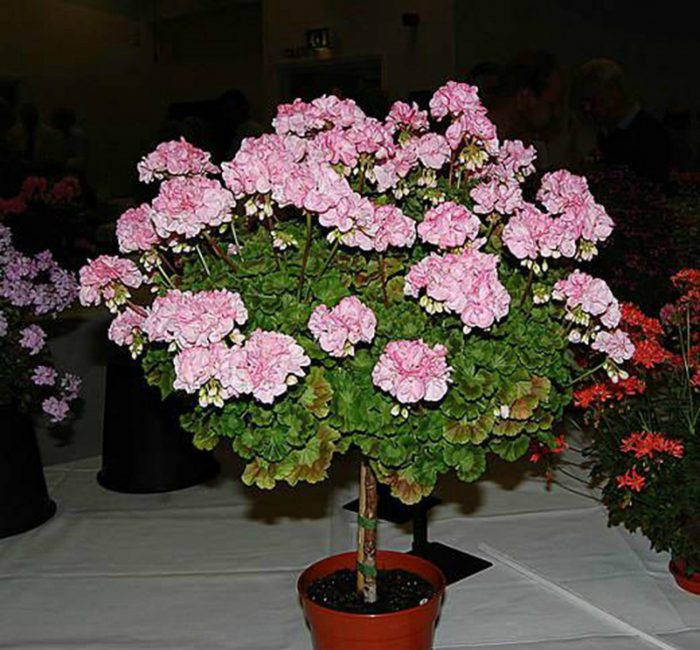
Stamper tree
A geranium bush can be formed into a small standard tree. To do this, remove all side shoots. Tie the trunk to the support. You need to fix it in several places. Given its fragility, it is necessary to produce a vertical garter carefully.
Pinch the top. This will cause forking. Of the resulting stems, about 7 pieces are left. to form the crown. Their tops are also pinched. The first flowers will appear in about a year, after the end of the formation of the crown.
The reasons for the lack of flowers on the geranium bush

Florists may be faced with the fact that geranium does not bloom
The reasons may vary. If the rules of care are not followed, it is worth bringing everything back to normal, and the bush will give you flowers.
Improper care criteria:
- Big pot
- Substrate not suitable
- The plant is not comfortable with the room temperature
- Not enough fertilizer
- Lack of watering or too much watering
- The stems are not cut or the procedure was not carried out on time
If these conditions are met, you need to add stress to the bush. Geranium is aimed at reproduction.
With changes in conditions, she will throw out a peduncle:
- Limit watering and feeding in the winter
- Trim tightly, leaving 1 - 2 knots. Royal geraniums cannot be circumcised.
- In the summer, take the plant outside, creating a change in temperature
- Drizzle with iodine water. 1 drop of iodine is taken per liter of water. 50 ml of the solution is poured slowly along the walls of the pot into the soil. Such irrigation ensures lush flowering.
- Water the root system with castor oil. A teaspoon of oil is dissolved in 1 liter of water. Watering with this mixture is necessary during the period of bud formation. In the resting stage, you cannot feed geraniums like that.
Geranium leaves turn yellow. Causes

Geranium leaves may turn yellow
As mentioned above, in winter this is a normal process. If yellowing occurs in summer.
It is necessary to look for and eliminate the reasons:
1 A tight bush pot provokes the death of leaves. When the root system fills all the space. The plant stops growing. The leaves begin to turn yellow. Transplanting into a larger pot will help
2 Insufficient or abundant watering has a detrimental effect on geraniums. It is necessary to bring the regime back to normal, remove damaged leaves.
3 There is no drainage, then it must be added to the bottom of the flower pot
4 Leaves may turn yellow from drafts. You need to rearrange the flower to another place
5If the temperature in the room is above +20 degrees, the geranium will begin to turn yellow. It is advisable to remove it in the shade.
6 Yellowing foliage can cause a lack or excess of light. Corrected by moving the bush to a more comfortable place
7 Fertilization plays an important role.It should be in sufficient quantity and correctly selected for the season. Otherwise, the foliage will begin to turn yellow and dry.

Sage: a description of its medicinal properties and possible contraindications for women and men, herbal infusions and other useful information about a natural healer
Geranium: home care for beginners
Even a beginner can handle indoor geranium care at home, since the plant is quite unpretentious
It is important to follow simple rules, maintain an optimal microclimate
Temperature and lighting
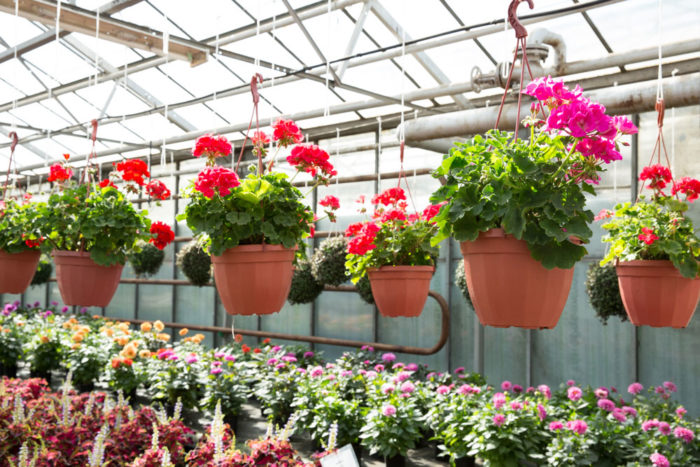
This light-loving plant is not afraid of direct sunlight. But on a hot summer day, to protect the leaves from sunburn, the window is slightly shaded. On ordinary days, you should not put the bush in the shade, because it will die.
Ampel geranium in the first days after purchase should stand for a couple of weeks in a well-lit place, but without direct sunlight. The bush will spend this time adapting to new conditions, after which it is gradually taken out onto a lighted windowsill.
In the warm season, the plant feels good at temperatures ranging from 22-27 ° C, but in winter the bush rests from abundant flowering, so at this time the optimal air temperature is 12-16 ° C. If the room is much warmer, the pot is taken out onto a well-insulated balcony, but placed away from heating appliances.
Watering and humidity
All varieties thrive in any humidity. The bush is not sprayed, because due to the ingress of water, the condition of the leaves and flowers will worsen
The only thing that is important for the endurance of the plant is fresh air, so in summer it is recommended to take the flower out to the balcony or keep it on the windowsill with an open window, but protect it from drafts
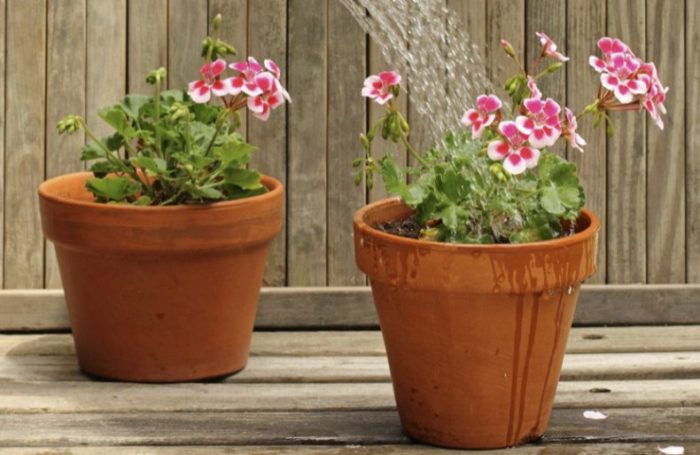
The optimal watering of geraniums in winter is 1 time in 7-10 days. In summer, the flower is watered as the top layer of the soil dries, but they try not to moisten the soil excessively so that the roots do not rot. For irrigation, use soft water at room temperature.
Top dressing geranium
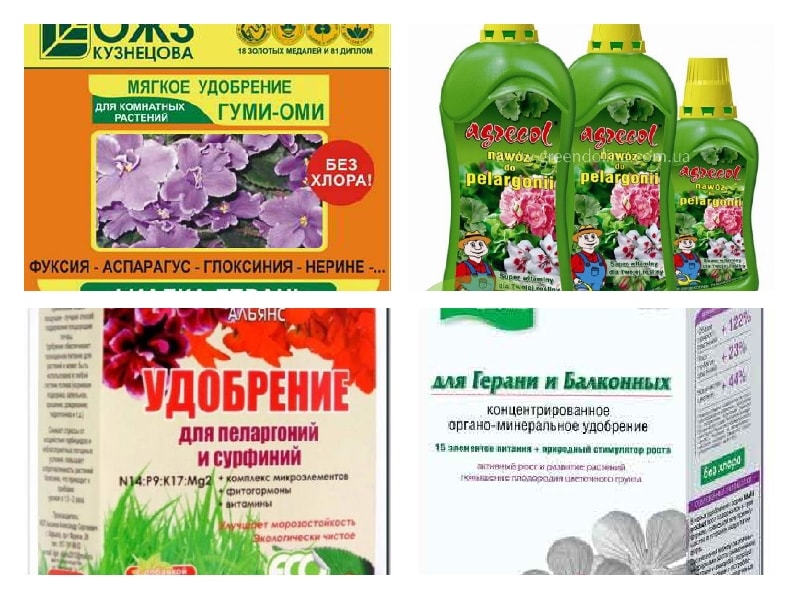
The bush is fed from March to August during its active flowering and growth. Potash fertilizers are usually used, which are applied twice a month. When choosing a complex composition, preference is given to mixtures with a minimum of nitrogenous compounds, because nitrogen promotes the growth of leaves, but inhibits flowering.
Soil selection and pot size
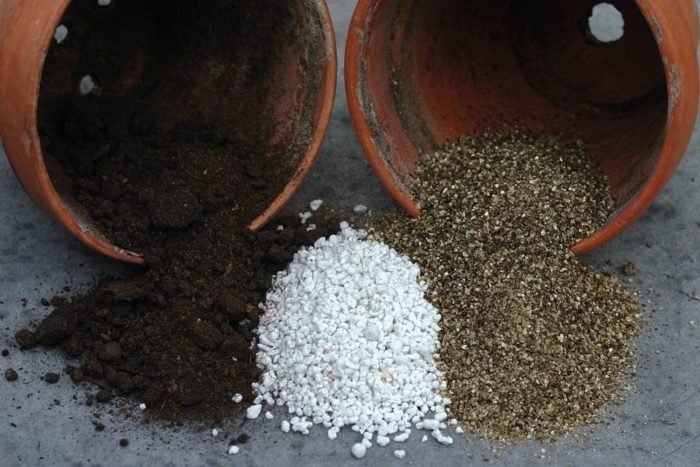
Caring for geraniums in a pot is about choosing the right container and choosing the right soil. A tropical bush loves loose soil that is rich in nutrients. A substrate for indoor plants with the addition of humus and sand is suitable. It is also easy to prepare a suitable soil from a mixture of turf, peat, sand and humus, taken in equal amounts.
For planting geraniums, small pots are chosen so that the plant does not waste energy on the development of the root system, does not stop blooming, and also hurts less. The width and height of the container should be approximately the same. At the bottom of the pot, drainage must be arranged to protect the roots from decay.
Reproduction of home geranium
Geranium propagation by seeds
Seed propagation of geraniums is not at all difficult. Purchased seeds germinate well and produce a large number of seedlings. The use of seeds collected from our own geraniums is unlikely to give the expected result, since during seed propagation, hybrid varieties lose the characteristics of the mother plant. Geranium seeds are sown in loose moist soil (peat, sand and turf soil in a ratio of 1: 1: 2), sprinkled on top with a layer of the same soil or sand two and a half centimeters thick. Spray on top with water from a spray bottle. So that the seedlings do not get sick with the "black leg", the substrate should first be shed with a pink solution of potassium permanganate. The planting should be covered with glass and regularly moisten the soil, while eliminating condensation. The temperature for seed germination is 18-22 ºC.When shoots appear, the glass is removed, the container is moved to a bright place, but the temperature is reduced to 16-20 ºC. After 1.5-2 months, the seedlings have 2-3 true leaves, and they can be planted in pots, and when 5-6 leaves appear, you can pinch the shoot to enhance tillering.
Propagation of geranium by cuttings
You can stock up on cuttings all year round, but it is better to do it in the spring. Geranium cuttings should be 5-7 cm long and have 2-3 leaves. The freshly cut stalk is dried for 24 hours, then the cut site is sprinkled with crushed coal and planted in a small pot with loose soil. Sometimes the cuttings are rooted in coarse sand, which should be slightly damp all the time, but when watering, the water should not get on the leaves and stems so that the plants do not rot. You do not need to cover the cuttings. After the cuttings have roots, they are transplanted into the ground to a permanent place. The optimum temperature for rooting cuttings is 20-22 ºC.


